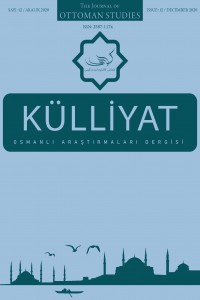Öz
While in terms of growth area it appeals to a large geography, Turkish Literature in the term of Ottoman Empire also has a world and content which are rich in terms of imagination.There are many works which include religious content in this literature area. Master Seyyid Mehmet who lived in 18. century is one of the poets who are famous for their works that have religious content. In this study, there is information about Master Seyyid Mehmed’s life, works and literary understanding who used the pseudonyms of Seyyid/Seyyidî. One of his poems which is present in one of the written journal the only copies of which was identified afterwards and which is in the a library of written works that belongs to the Religious Affairs Administration, entitled as “Hazâ Nazm-ı Peyğamberân-ı Aleyhi’s-selâm”, “Nazm-ı Çahâr Yâr”, “Beyt-i Nazm-ı İmâm-ı Azam Hazretleri”, “Nazm-ı Ravzâ-i Mutahhara”, “Nazm-ı Mekke-i Mükerreme Şerefehâllâhu” is subjected to be studied. Poems in question are the poems that are on the subjects of comparison of prophets, narrations of religious men, narration of protectors which were produced in the field of civilization of Islam and writing on worship of hajj and writings on hajj headway which embraces hajj and sacred places as subject. Poems were written in the form of verse of mesnevi and with the aruz prosody in the frame of the basis of classic literature. Master Seyyid Mehmed from Konya used a simple and understandable language as he gave importance to the didactic quality. Being translated into today’s alphabet, poems written by Master Seyyid Mehmed from Konya have been presented for the focus of the world of science.
Anahtar Kelimeler
Kaynakça
- Donuk, Suat(2019). Bursa Enarlı Zaviyesi Şeyhi Seyyid Mehmed Efendi ve Manzum Hac Menâzilnâmesi, Uludağ Üniversitesi İlahiyat Fakültesi Dergisi, 28(1),129.
- Durak, Ahmet.(2018). Osmanlı Devleti’nde Surre-i Hümayun Geleneği “18 Ekim 1656 Tarihli Mekke’ye Gönderilen Defter Örneği” Külliyat(Osmanlı Araştırmaları Dergisi), Nisan,(4),25-27.
- Eliaçık, Muhittin.(2008). Din Hizmetlerinde Şiir ve Manzum Metinlerin Yeri, I. Din Hizmetleri Sempozyumu(3-4 Kasım 2007), Ankara: Diyanet İşleri Başkanlığı Yay.
- Karahan, Abdülkadir.(2002). Kırk Hadis (Türk Edebiyatı), Türkiye Diyanet Vakfı İslam Ansiklopedisi. İstanbul: Diyanet Vakfı Yay.
- Karataş, Ahmet.(2013). Kısas-ı Enbiya Peygamber Kısaları, İstanbul: Türkiye Yazma Eserler Kurumu Başkanlığı
Öz
Osmanlı Dönemi Türk Edebiyatı, gelişim sahası olarak büyük ve geniş bir coğrafyaya hitap ettiği gibi zengin bir muhayyile dünyasına ve muhtevaya da sahiptir. Bu edebiyat sahası içerisinde dinî muhtevaya havi binlerce eser yer almaktadır. 18. yüzyılda yaşamış olan Konyalı Seyyid Mehmed Efendi dinî muhtevaya sahip eserleriyle tanınan şairlerden biridir. Çalışmamızda Seyyid/Seyyidî mahlaslarını kullanan Konyalı Seyyid Mehmed Efendi’nin hayatı, eserleri ve edebî anlayışı hakkında bilgilere yer verilmiştir. Daha sonra tespit edilebilmiş tek nüshası Diyanet İşleri Başkanlığı Yazma Eserler Kütüphanesi’nde bulunan bir yazma mecmuanın içerisinde yer alan “Hazâ Nazm-ı Peyğamberân-ı Aleyhi’s-selâm”, “Nazm-ı Çahâr Yâr”, “Beyt-i Nazm-ı İmâm-ı Azam Hazretleri”, “Nazm-ı Ravzâ-i Mutahhara”, “Nazm-ı Mekke-i Mükerreme Şerrefehâllâhu” başlıklı manzumeleri incelemeye tabi tutulmuştur. Söz konusu manzumeler, İslam medeniyeti sahasında meydana getirilen kısas-ı enbiya veya enbiya-name, menakıpname ile hac farizasını ve kutsal mekânları konu edinen menasikname ve hacname konulu manzumelerdir. Manzumeler, klasik edebiyatın esasları çerçevesinde mesnevî nazım şekli ve aruz vezni ile kaleme alınmışlardır. Konyalı Seyyid Mehmed Efendi, şiirlerinde öğreticiliği önemsediğinden sade ve anlaşılır bir dil kullanmıştır. Konyalı Seyyid Mehmet Efendi tarafından kaleme alınmış manzumeler çeviri yazı ile bugünkü alfabemize aktarılarak ilim dünyasının dikkatine sunulmuştur.
Anahtar Kelimeler
Kaynakça
- Donuk, Suat(2019). Bursa Enarlı Zaviyesi Şeyhi Seyyid Mehmed Efendi ve Manzum Hac Menâzilnâmesi, Uludağ Üniversitesi İlahiyat Fakültesi Dergisi, 28(1),129.
- Durak, Ahmet.(2018). Osmanlı Devleti’nde Surre-i Hümayun Geleneği “18 Ekim 1656 Tarihli Mekke’ye Gönderilen Defter Örneği” Külliyat(Osmanlı Araştırmaları Dergisi), Nisan,(4),25-27.
- Eliaçık, Muhittin.(2008). Din Hizmetlerinde Şiir ve Manzum Metinlerin Yeri, I. Din Hizmetleri Sempozyumu(3-4 Kasım 2007), Ankara: Diyanet İşleri Başkanlığı Yay.
- Karahan, Abdülkadir.(2002). Kırk Hadis (Türk Edebiyatı), Türkiye Diyanet Vakfı İslam Ansiklopedisi. İstanbul: Diyanet Vakfı Yay.
- Karataş, Ahmet.(2013). Kısas-ı Enbiya Peygamber Kısaları, İstanbul: Türkiye Yazma Eserler Kurumu Başkanlığı
Ayrıntılar
| Birincil Dil | Türkçe |
|---|---|
| Konular | Sanat ve Edebiyat |
| Bölüm | Edebiyat |
| Yazarlar | |
| Yayımlanma Tarihi | 31 Aralık 2020 |
| Gönderilme Tarihi | 14 Eylül 2020 |
| Kabul Tarihi | 14 Ocak 2021 |
| Yayımlandığı Sayı | Yıl 2020 Sayı: 12 |


